

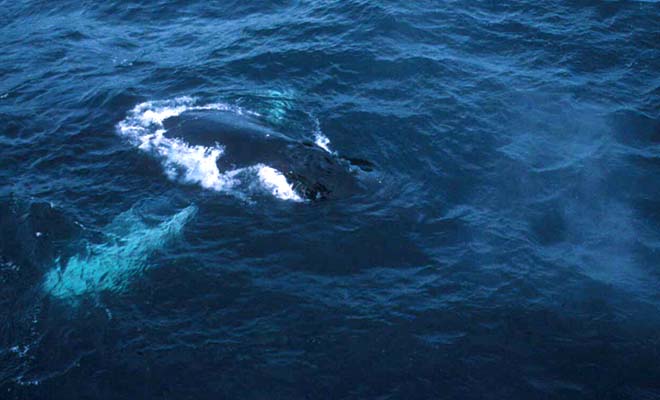 Perhaps
the most viewed whales in Monterey Bay are the Humpback Whales in summer
and fall, and the Gray Whales in winter and spring. Boat trips devoted
to searching out these migrating whales depart almost daily from Fisherman's
Wharf in Monterey, and also from Moss Landing and Santa Cruz harbors. By
far the most acrobatic and personable is the
Humpback Whale
Megaptera
novaeangliae. Some animals seem positively attracted to boats and can
be curious, spy-hopping and rolling to get views. Their long white pectoral
fins may be waved or slapped on the ocean surface, and can be seen below
the water when looking down on a Humpback (left). Perhaps
the most viewed whales in Monterey Bay are the Humpback Whales in summer
and fall, and the Gray Whales in winter and spring. Boat trips devoted
to searching out these migrating whales depart almost daily from Fisherman's
Wharf in Monterey, and also from Moss Landing and Santa Cruz harbors. By
far the most acrobatic and personable is the
Humpback Whale
Megaptera
novaeangliae. Some animals seem positively attracted to boats and can
be curious, spy-hopping and rolling to get views. Their long white pectoral
fins may be waved or slapped on the ocean surface, and can be seen below
the water when looking down on a Humpback (left). |
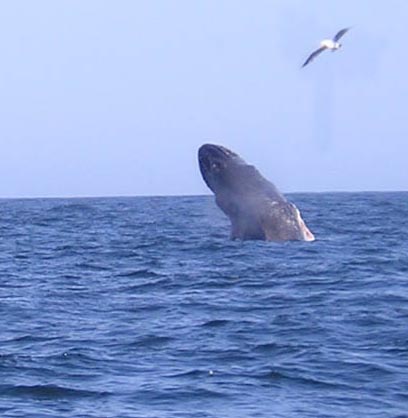
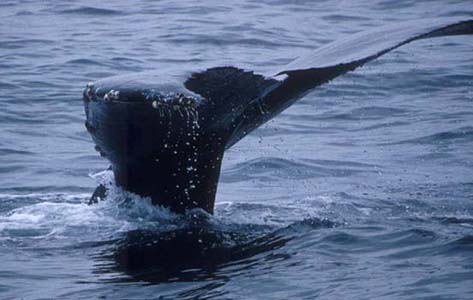 Unless
one is lucky enough to see a Humpback in a full breaching leap out of the
water (above), it can be hard to get a good idea of what they look
like. But they are often very accommodating, and one can eventually have
nice views of the head (below), dorsal surface (second shot below),
and tail (right). Unless
one is lucky enough to see a Humpback in a full breaching leap out of the
water (above), it can be hard to get a good idea of what they look
like. But they are often very accommodating, and one can eventually have
nice views of the head (below), dorsal surface (second shot below),
and tail (right). |
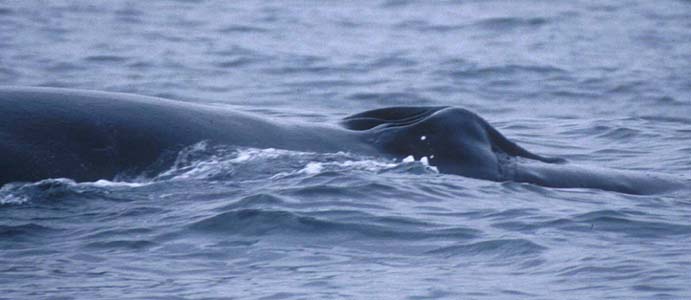 |
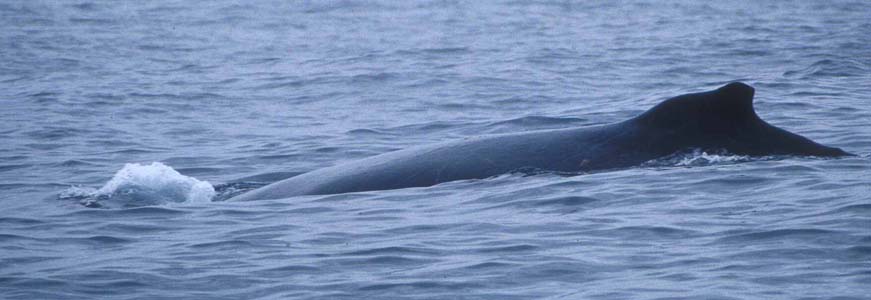 |
|
|
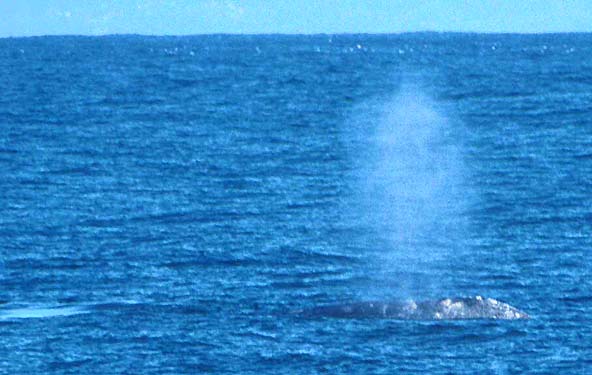
The whale that started the whole whale-watching industry is the Gray Whale Eschrichtius robustus (right and below). Its annual migration along the California coastline is both predictable and impressive. Whales are heading south in late fall and early winter, and then north again in late winter and spring. This migration can be watched from many points along the local coastline, including Pt. Pinos, Pt. Joe, Cypress Pt., Pt. Lobos, Pt. Sur and the Molera headlands, various pull-outs along Hwy 1 south of Big Sur, and from the hot tubs at Esalen. |
| With Gray Whales, one usually notes the blow (above), then an arched back without any dorsal fin (below left), and then the tail flukes (below right), although there are times when Gray Whales will breech and come nearly out of the water. I recall one wintry day about ten years ago when I was scoping Monterey Bay from Otter Pt. in Pacific Grove, and looking east at a light dusting of snow on the Santa Lucia Mountains (a rare event here), when a baby Gray Whale suddenly leaped from the Bay just off Cannery Row, providing a once-in-a-lifetime spectacle of nature. |
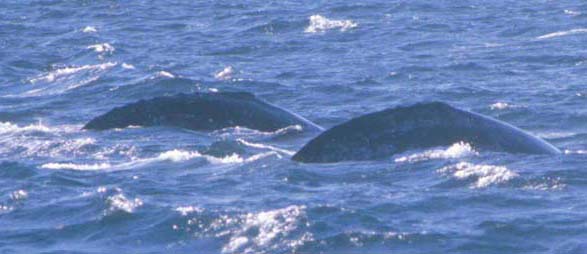 |
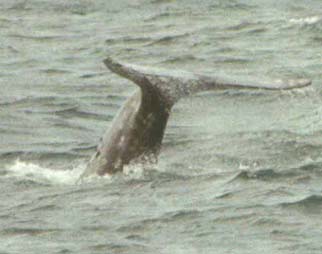 |
| There have been times offshore when a Gray Whale approached our boat so closely that its barnacles could be seen (right), but one must remember that Gray Whales were almost hunted to extinction and are still a threatened species. | 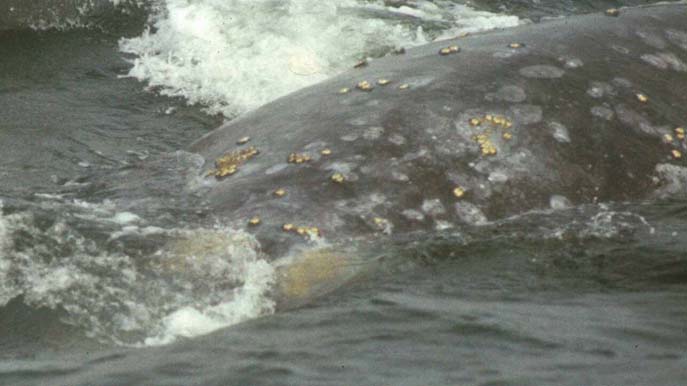 |
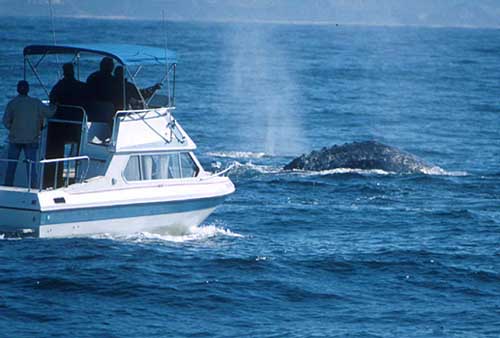 |
Therefore it is illegal to purposefully chase a Gray Whale closely, as this small boat is doing. We reported this rouge to the authorities. |
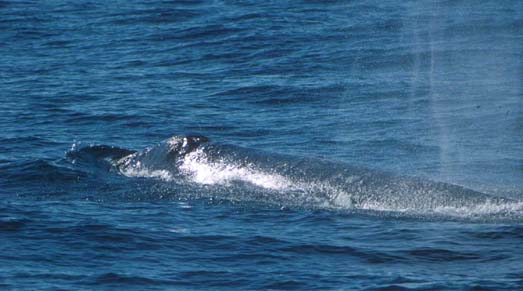 There
are many fascinating aspects of the Gray Whale's biology and its history.
In summer they feed in the mud at the bottom of the Bering Sea, lying of
their sides to scoop mud (and all the critters within that muck) into their
mouths where they strain out the 'good' stuff. Then in fall they migrate
south down the North American coastline, mating and cavorting enroute,
until they reach the lagoons of Baja California where the adult females
give birth to young. An entire tourist industry exists to view Gray Whales
closely at Santa Ignacio and other lagoons. Then, in spring, they head
north again. Along the way they must pass the gauntlet of roving bands
of Killer Whales (Orca). There
are many fascinating aspects of the Gray Whale's biology and its history.
In summer they feed in the mud at the bottom of the Bering Sea, lying of
their sides to scoop mud (and all the critters within that muck) into their
mouths where they strain out the 'good' stuff. Then in fall they migrate
south down the North American coastline, mating and cavorting enroute,
until they reach the lagoons of Baja California where the adult females
give birth to young. An entire tourist industry exists to view Gray Whales
closely at Santa Ignacio and other lagoons. Then, in spring, they head
north again. Along the way they must pass the gauntlet of roving bands
of Killer Whales (Orca). |
|
|
|
| About everything you might want to know about Gray Whales is found the Monterey Bay Aquarium's booklet Gray Whales (1991) by David Gordon and Alan Baldridge. It is filled with maps, great photos, and wonderful stories. It also contains an excellent summary of historic whaling in Monterey Bay and the whaling stations along our coast. I cannot recommend it too highly! |
|
GO BACK TO PAGE ON BLUE, FIN, SEI & MINKE WHALES |
|
|
|
|
|
|
|
|
|
|
|
|
|
|